Coronavirus Update
No soy epidemeólogo (01), ni virólogo (02), ni médico (03), ni inmunólogo (04), ni infectólogo (05), ni farmacéutico (06), ni vacunólogo (07), ni pediatra (08) y no tengo experiencia propia - sea de investigación o de docencia - respecto a los virus. Pero como biólogo tengo conocimiento generalizado a respecto y ahora trado de difundir conceptos con bases científicas sobre el Coronavirus dejando la información de redes sociales a un lado.
Redirect @
https://apps.cuci.udg.mx/bch/ES/CoV2.html
in 10 sec.
Coronavirus
|
Son of Omicron |
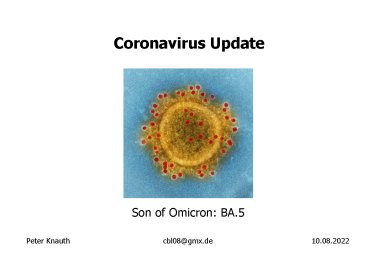
|
References:
Wang et al. (2022): Estimating excess mortality due to the COVID-19 pandemic: a systematic analysis of COVID-19-related mortality, 2020-21. Lancet, 399: 1513-36
Worobey et al. (2022): The Huanan Seafood Wholesale Market in Wuhan was the early epicenter of the COVID-19 pandemic. Sci., epub
Pekar et al. (2021): Timing the SARS-CoV-2 index case in Hubei province. Sci., 372: 412-7
Pekar et al. (2022): The molecular epidemiology of multiple zoonotic origins of SARS-CoV-2. Sci., epub
Bojkova et al. (2022): SARS-CoV-2 Omicron variant virus isolates are highly sensitive to interferon treatment. bioRxiv
Cao et al. (2022): BA.2.12.1, BA.4 and BA.5 escape antibodies elicited by Omicron infection. Nat., epub
Kimura et al. (2022): Virological characteristics of the novel SARS-CoV2 Omicron variants including BA.2.12.1, BA.4 and BA.5. bioRxiv
Shen et al. (2022): ACE2-independent infection of T-lymphocytes byl SARS-CoV2. Signal Transduct. Target. Ther., 7: 83
Reynolds et al. (2022): Immune boosting by B.1.1.529 (Omicron) depends on previous SARS-CoV2 exposure. Sci., 377
Menni et al. (2022): COVID-19 vaccine waning and efectiveness and side-efects of boosters: a prospective community study from the ZOE COVID Study. Lancet Infect. Dis., 22: 1002-10
Quandt et al. (2022): Omicron BA.1 breakthrough infection drives cross-variant neutralization and memory B cell formation against conserved epitopes. Sci. Immunol., epub
Magen et al. (2022): Fourth dose of BNT162b2 mRNA Covid19 vaccine in a nationwide setting. NEJM, 386: 1603-14
Cohen et al. (2022): Mosaic RBD nanoparticles protect against challenge by diverse sarbecoviruses in animal models. Sci., 377: id618
Gagne et al. (2022): mRNA-1273 or mRNA-Omicron boost in vaccinated macaques elicts comparable B cell expansion, neutralizing antibodies and protection against Omicron. bioRxiv
BioNTech press release on efficacy of adapted vaccine.
Kuodi et al. (2022): Association between vaccination status and reported incidence of post-acute Covid19 symptoms in Israel: a cross-sectional study of patients tested between March 2020 and November 2021. medRxiv
Antonelli et al. (2022): Risk of long Covid associated with delta versus omicron variants of SARS-CoV-2. Lancet, 399: 2263-4
NDR-Info (2022): Podcast mit Drosten & Ciesek: Long Covid und Post Covid
Smyth et al. (2022): Tracking cryptic SARS-CoV2 lineages detected in NYC wastewater. Nat. Commun., 13: 635
|
Ominous Omicron |
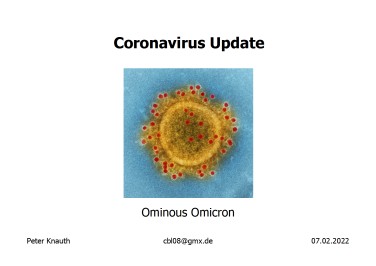
|
References:
Abdullah (2021): Tshwane district Omicron variant patient profile: early features.
Brandal et al. (2021): Outbreak caused by the SARS-CoV-2 Omicron variant in Norway, Nov. to Dec. 2021. Euro Surveill., 26: id 2101147
CDC about variant proportions
Plesner-Lyngse et al. (2021): SARS-CoV2 Omicron VOC transmission in Danish households. medRxiv
Zhang et al. (2021): The significant immune escape of pseudotyped SARS-CoV-2 variant Omicron. Emerg. Microbes & Infect., 11: id 2017757
Garcia-Beltran et al. (2021): mRNA-based COVID-19 vaccine boosters induce neutralizing immunity against SARS-CoV2 Omicron variant. Cell, 185: 457-66
Pulliam et al. (2021): Increased risk of SARS-CoV-2 reinfection associated with emergence of the Omicron variant in South Africa. medRxiv
Meng et al. (2021): SARS-CoV-2 Omicron spike mediated immune escape, infectivity and cell-cell fusion. bioRxiv
Servellita et al. (2022): Neutralizing immunity in vaccine breakthrough infections from the SARS-CoV-2 Omicron and Delta variants. medRxiv
Burgers & Riou (2021): Preliminary experimental data on T cell cross-reactivity to Omicron.
Ahmed et al. (2022): OSARS-CoV-2 T-Cell responses elicited by COVID-19 vaccines or infection are expected to remain robust against Omicron. viruses, 14: id 0079
Bojkova et al. (2021): Reduced interferon antagonism but similar drug sensitivity in Omicron variant compared to Delta variant of SARS-CoV-2 isolates. Nat. Cell Res., DOI 10.1038/s41422-022-00619-9
Chi-wai et al. (2021): HKUMed finds Omicron SARS-CoV2 can infect faster and better than Delta in human bronchus but with less severe infection in lung.
Lewnard et al. (2022): Clinical outcomes among patients infected with Omicron (B.1.1.529) SARS-CoV2 variant in southern California. medRxiv
Modes et al. (2022): Clinical characteristics and outcomes among adults hospitalized with laboratory-confirmed SARS-CoV2 infection during periods of B.1.617.2 (Delta) and B.1.1.529 (Omicron) variant predominance. MMWR, 71: e-pub
Hay et al. (2022): Viral dynamics and duration of PCR positivity of the SARS-CoV-2 Omicron variant. pre-print
Wang et al. (2022): COVID infection severity in children under 5 years old before and after Omicron emergence in the US. medRxiv
Danish Covid-19 Genome Consortium about SARS-CoV-2 propagation in Denmark.
Plesner-Lyngse et al. (2022): Transmission of SARS-CoV-2 Omicron VOC subvariants BA.1 and BA.2: evidence from Danish households. medRxiv
GOV-11226 (2022): COVID-19 vaccine surveillance, 4th week. UK Health Security Agency
Pfizer press release on new vaccine.
Registration of Clinical Trial from Pfizer of new vaccine.
Registration of Clinical Trial from Moderna of new vaccine.
Martinez et al. (2021): Chimeric spike mRNA vaccines protect against Sarbecovirus challenge in mice. Sci, 373: 991-8
|
Variante Delta |
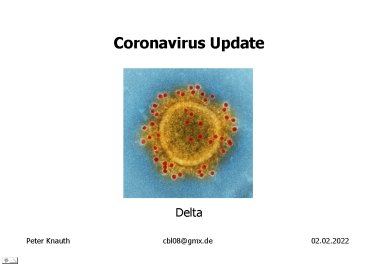
|
References:
CDC about Delta variant
Khan-Burki (2021): Lifting of COVID-19 restrictions in the UK and the Delta variant. Lancet 9: e85
Xiang-Ong et al. (2021): Clinical and virological features of SARS-CoV-2 variants of concern: a retrospective cohort study comparing B.1.1.7 (Alpha), B.1.315 (Beta) and B.1.617.2 (Delta). Lancet-preprint
Li et al. (2022): Viral infection and transmission in a large, well-traced outbreak caused by the SARS-CoV-2 Delta variant. Nat. Commun., 13: id460
Fisman & Tuite (2021): Progressive increase in virulence of novel SARS-CoV-2 variants in Ontario, Canada. medRxiv
Lopez-Bernal et al. (2021): Effectiveness of COVID-19 vaccines against the Delta variant. NEJM, 385: 585-94
Stowe et al. (2021): Effectiveness of COVID-19 vaccines against hospital admission with the Delta variant. PHE publishing preprint
Scobie et al. (2021): Monitoring incidence of COVID-19 cases, hospitalizations and deaths by vaccination status. MMWR, 70: 1284-90
Israel et al. (2021): Elapsed time since BNT162b2 vaccine and risk of SARS-CoV-2 infection: test negative design study. Brit. Med. J., 375: 67873
Juthani et al. (2021): Hospitalisation among vaccine breakthrough COVID-19 infections. Lancet, 21: 1485-6
Ying-Chia et al. (2021): Virological and serological kinetics of SARS-CoV-2 Delta variant vaccine-breakthrough infections. Clin. Microbiol. Infect. e-pub
Eyre et al. (2022): The impact of SARS-CoV-2 vaccination on Alpha & Delta variant transmission. NEJM, e-pub
Arbel et al. (2021): BNT162b2 vaccine booster and mortality due to Covid-19. NEJM, 385: 2413-20
Roessler et al. (2021): Post COVID-19 in children, adolescents and adults: results of a matched cohort study including more than 150,000 individuals with COVID-19. medRxiv
Barrett et al. (2022): Risk for newly diagnosed Diabetes >30 d after SARS-CoV2 infection among persons aged <18 years. MMWR, 71: 59-65
Theuerkauf et al. (2021): Quantitative assays reveal cell fusion at minimal levels of SARS-CoV2 spike protein and fusion from without. iSci., 24: id102170
Bernal et al. (2021): Molnupiravir for oral treatment of Covid-19 in nonhospitalized patients. NEJM, e-pub
de Vries et al. (2021): A comparative analysis of SARS-CoV-2 antivirals characterizes 3CLpro inhibitor PF-00835231 as a potential new treatment for COVID-19. J. Virol., 95: id01819-20
Owen et al. (2021): An oral SARS-CoV-2 Mpro inhibitor clinical candidate for the treatment of COVID-19. Sci., 374: 1586-93
Clinical trials on Paxlovid
Pfizer press release on Paxlovid
Abdelnabi et al. (2021): The oral protease inhibitor (PF-332) protects Syrian hamsters against infection with SARS-CoV2 variants of concern. bioRxiv
Heskin et al. (2022): Caution required with use of ritonavir-boosted PF-07321332 in COVID-19 management. Lancet 399: 21-22
WHO approved vaccines
Dunkle et al. (2021): Efficacy and Safety of NVX-CoV2373 in Adults in the United States and Mexico. NEJM, id2116185
|
| 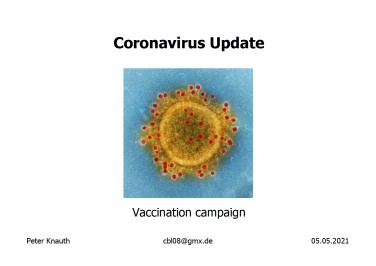
|
| Mutaciones en SARS-CoV2 y aspectos generales de seguridad de vacunas contra SARS-CoV-2 |
Vacunas contra SARS-CoV-2 (BioNTech, AstraZeneca, Sputnik, Cansino)
Corrección: La vacuna de Cansino contiene ~5*1010 pfu.
|
References (A):
Brown et al. (2021): Increased transmission of SARS-CoV-2 lineage B.1.1.7 (VOC 2020212/01) is not accounted for by a replicative advantage in primary airway cells or antibody escape. bioRxiv
Kissler et al. (2021): Densely sampled viral trajectories suggest longer duration of acute infection with B.1.1.7 variant relative to non-B.1.1.7 SARS-CoV-2. preprint
Tegally et al. (2020): Emergence and rapid spread of a new severe acute respiratory syndrome-related coronavirus 2 (SARS-CoV-2) lineage with multiple spike mutations in South Africa. medRxiv
Altmann et al. (2021): Immunity to SARS-CoV2 variants of concern. Sci., 371: 1103-4
Faria et al. (2021): Genomic characterisation of an emergent SARS-CoV-2 lineage in Manaus: preliminary findings. preprint
Naveca et al. (2021): COVID-19 epidemic in the Brazilian state of Amazonas was driven by long-term persistence of endemic SARS-CoV-2 lineages and the recent emergence of the new Variant of Concern P.1. preprint
Buss et al. (2021): Three-quarters attack-rate of SARS-CoV2 in the Brazilian Amazon during largely unmitigated epidemic. Sci., 371: 288-92
Sabino et al. (2021): Resurgence of COVID19 in Manaus, Brazil, despite high seroprevalence. Lancet, 397: 452-5
Muñoz-Medina et al. (2021): SARS-CoV2 IgG antibodies seroprevalence and sera neutralizing activity in Mexico. Microorg., 6: 850
Deng et al. (2021): Densely sampled viral trajectories suggest longer duration of acute infection with B.1.1.7 variant relative to non-B.1.1.7 SARS-CoV-2. preprint Cell
Ritter et al. (2002): Improvements in Gene Therapy: Averting the Immune Response to Adenoviral Vectors. BioDrugs, 16: 3-10
Mitani & Kubo (2002): Adenovirus as an integrating vector. Curr. Gene Thera., 2: 135-44
Black et al. (2009): Importance of background rates of diseases in assessment of vaccine safety during mass immunisation with pandemic H1N1 influenza vaccines. Lancet, 374: 2115-22
Lokugamage et al. (2008): Chimeric coronavirus-like particles carrying severe acute respiratory syndrome coronavirus (SCoV) S protein protect mice against challenge with SCoV. Vaccine, 26: 797-808
Tseng et al. (2012): Immunization with SARS coronavirus vaccines leads to pulmonary immunopathology on challenge with the SARS virus. Plos1, 7: e35421
Liu et al. (2019): Anti-spike IgG causes severe acute lung injury by skewing macrophage responses during acute SARS-CoV infection. JCI Insight, 4: e123158
Wu et al. (2020): Antibody-dependent enhancement (ADE) of SARS-CoV-2 infection in recovered COVID-19 patients: studies based on cellular and structural biology analysis. medRxiv
Gao et al. (2020): Rapid development of an inactivated vaccine for SARS-CoV-2. bioRxiv
Ahmed et al. (2015): Antibodies to influenza nucleoprotein cross-react with human hypocretin receptor 2. Sci. Translat. Med., 7: 294ra105
Buchbinder et al. (2008): Efficacy assessment of a cell-mediated immunity HIV-1 vaccine (the Step Study). Lancet, 372: 1881-93
Duerr et al. (2012): Extended follow-up confirms early vaccine-enhanced risk of HIV acquisition and demonstrates warning effect over time among participants in a randomized trial of recombinant adenovirus. J. Infect. Dis., 206: 258-66
Buchbinder et al. (2020): Use of adenovirus type-5 vectored vaccines: a cautionary tale. Lancet, 396: e68-9
References (B):
Pollack et al. (2020): Safety and efficacy of the BNT162b2 mRNA Covid19 vaccine. NEJM, 383: 2603-15
Voysey et al. (2021): Safety and efficacy of the ChAdOx1 nCoV19 vaccine (AZD1222) against SARS-CoV2. Lancet, 397: 99-111
Krutzke et al. (2021): Process-related impurities in the ChAdOx1 nCov-19 vaccine. Preprint
Logunov et al. (2021): Safety and efficacy of rAd26 and rAd5 vector based heterologous prime-boost COVID19 vaccine. Lancet, 397: 671-81
Ostergaard et al. (2021): Thromboembolism and the Oxford-AstraZeneca COVID-19 vaccine: side-effect or coincidence? Lancet, 397: 1441-3
Skajaa et al. (2019): Venous thromboembolism in Denmark: seasonality in occurrence and mortality. TH Open, 3: e171-e179
Greinacher et al. (2021): A prothrombotic thrombocytopenic disorder resembling Heparin-Induced Thrombocytopenia following Coronavirus-19 vaccination. preprint
Zhu et al. (2020): Safety, tolerability and immunogenicity of a recombinant adenovirus type-5 vectored COVID19 vaccine. Lancet, 395: 1845-54
Zhu et al. (2020): Immunogenicity and safety of a recombinant adenovirus type-5 vectored COVID19 vaccine in healthy adults aged 18 years or older. Lancet, 396: 479-88
Xie et al. (2021): Neutralization of N501Y mutant SARS-CoV2 by BNT162b2 vaccine-elicited sera. bioRxiv
Liu et al. (2021): Neutralizing activity of BNT162b2-elicited serum. NEJM, 384
Emary et al. (2021): Efficacy of ChAdOx1 nCoV19 (AZD1222) vaccine against SARS-CoV2 (B.1.1.7). preprint
Fischer et al. (2021): ChAdOx1 nCoV-19 (AZD1222) protects against SARS-CoV-2 B.1.351 and B.1.1.7. bioRxiv
Krammer et al. (2021): Robust spike antibody responses and increased reactogenicity in seropositive individuals after a single dose of SARS-CoV-2 mRNA vaccine. medRxiv
Dan et al. (2021): Immunological memory to SARS-CoV2 assessed for up to 8 month after infection. Sci.
|
Un año Covid-19 |
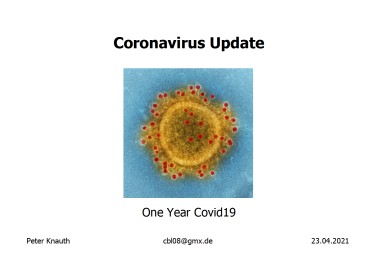
|
References:
Brauner et al. (2021): Interferring the effectiveness of government interventions against COVID-19. Sci. 371: eabd9338
Dorn et al. (2020): Das gemeinsame Interesse von Gesundheit und Wirtschaft. ifo Schnelldienst. 06/2020
Silva et al. (2021): Saliva viral load is a dynamic unifying correlate of COVID-19 severity and mortality. medRxiv
Le Bert et al. (2021): Highly functional virus-specific cellular immune response in asymptomatic SARS-CoV2 infection. J. Exp. Med. 218: e20202617
Muus et al. (2021): Single-cell meta-analysis of SARS-CoV2 entry genes across tissues and demographics. Nat. Med. 27: 546-559
Pairo-Castineira et al. (2020): Genetic mechanisms of critical illness in COVID19. Nat. 591: 92-8
Shelton et al. (2020): Trans-ethnic analysis reveals genetic and non-genetic associations with COVID19 susceptibility and severity. medRxiv
Liu et al. (2020): The impact of AB0 blood group on COVID19 infection risk and mortality. Blood Rev. id100785
Bhattacharjee et al. (2020): AB0 blood groups and severe outcome in COVID19. Postgrad. Med. J. id139248
Zhang et al. (2021): Association between AB0 blood types and COVID19, genetic associations and underlying molecular mechanisms. Ann. Hematol. 100: 1123-32
Rosas et al. (2021): Tocilizumab in hospitalized patients with servere Covid19 pneumonia. NEJM 384:1503-16
Gordon et al. (2021): Interleukin-6 receptor antagonist in critically ill patients with Covid19. NEJM 384:1491-502
Horby et al. (2021): Tocilizumab in patients admitted to hospital with COVID19 (recovery). medRxiv
Davoudi-Monfared et al. (2020): Efficiency and safety on interferon-b 1a in treatment of severe COVID19. medRxiv
Pan et al. (2021): Repurposed antiviral drugs for Covid19. NEJM 384: 497-511
Franchini et al. (2021): Why should we use convalescent plasma for COVID19? Eur. J. Int. Med. 137: 1573-81
Simonovich et al. (2021): A randomized trial of convalescent plasma in Covid19 severe pneumonia. NEJM 384: 619-29
Libster et al. (2021): Early high-titer plasma therapy to prevent severe Covid19 in older adults. NEJM 384: 610-8
Cox et al. (2021): Therapeutically administered ribonucleoside analogue MK-4482/EIDD-2801 blocks SARS-CoV2 transmission in ferrets. Nat. Microbiol. 6: 11-8
Caly et al. (2020): The FDA-approved drug Ivermectin inhibits the replication of SARS-CoV2 in vitro. Antiv. Res. 178: id104787
López-Medina et al. (2021): Effect of Ivermectin on time to resolution of symptoms among adults with mild Covid19. JAMA 325: 1426-35.
Kanjanaumporn et al. (2020): Smell and taste dysfunction on patients with SARS-CoV2 infection. APJAI 38: 69-77
Dias de Melo et al. (2020): COVID19 associated olfactory dysfunction reveals neuroinvasion and persistance in the olfactory system. bioRvix
Hampshire et al. (2020): Cognitive deficits in people ho have recovered from COVID19 relative to controls. medRxiv
Cirulli et al. (2020): Long-term COVID19 symptoms in a large unselected population. medRxiv
Huang et al. (2021): 6-month consequences of COVID19 in patients discharged from hospital. Lancet 397: 220-32
Mandal et al. (2021): Long-COVID19: a cross sectional study of persisting symptoms, biomarker and imaging abnormalities following hospitalisation for COVID19. Thorax id215818
López-Leon et al. (2021): More than 50 long-term effects of COVID19. medRxiv
Dennis et al. (2020): Multi-organ impairment in low-risk individuals with long COVID. medRxiv
|
Niños en tiempos de Covid-19 |
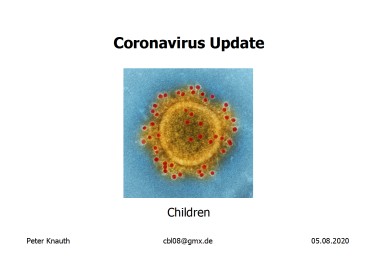
|
References:
Liguoro et al. (2020): SARS-CoV2 infection in children and newborns: a systematic review. Eur. J. Pediatr.
Zhang et al. (2020): Changes in contact patterns shape the dynamics of the COVID-19 outbreak in China. Sci.
Dattner et al. (2020): The role of children in the spread of COVID-19: using household data from Bnei Brak, Israel, to estimate the relative susceptibility and infectivity of children. medRxiv
Tegmark et al. (2020): Förekomsten av covid-19 i region Stockholm, 26 mars-3 april 2020. Folkhälsomyndigheten #20051
Heald-Sargent et al. (2020): Age-related differences in nasopharyngeal severe acute respiratory syndrome Coronavirus 2 (SARS-CoV-2) levels in patients with mild to moderate Coronavirus disease 2019 (COVID-19). J. Am. Med. Assoc. Pediatr.
Fontanet et al. (2020): Cluster of COVID-19 in northern France: a retrospective closed cohort study. medRxiv
Difusión por Radio UdG en el Programa "Eureka":
Niños y se puede reabrir las escuelas? con Zaira López y Peter Knauth (12.08.2020)
La nueva normalidad con Zaira López y Peter Knauth (15.07.2020)
Su-sana Distancia y Sanitización con Selene Huerta y Peter Knauth (08.07.2020)
Cubre-boca-nariz con Selene Huerta y Peter Knauth (01.07.2020)
Medicamentos contra Covid-19 con Selene Huerta (01.07.2020)
Vacunas 2 con Zaira López y Eduardo Cano (24.06.2020)
Vacunas 1 con Zaira López y Eduardo Cano (17.06.2020)
|
Vacunas contra Covid-19 |
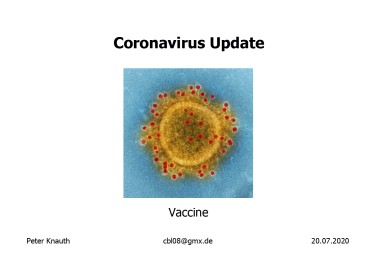
|
References:
Fu et al. (2020): Understanding SARS-CoV-2-mediated inflammatory responses: From mechanisms to potential therapeutic tools. Virol. Sin.
Zhou & Zhao (2020): Perspectives on therapeutic neutralizing antibodies against the novel coronavirus SARS-CoV-2. Int. J. Biol. Sci.
Arvin et al. (2020): A perspective on potential antibody-dependent enhancement of SARS-CoV-2. Nature
Liu et al. (2019): Anti-spike IgG causes severe acute lung injury by skewing macrophage responses during acute SARS-CoV infection. Cell
New York Times Vaccine-Tracker
Janssen Pharmaceuticals hace la investigación y el desarrollo de medicamentos para Johnson & Johnson.
|
Medicina para tratar Covid-19 |

|
References:
Jean et al. (2020): Treatment options for Covid-19: the reality and challenges. J. Microbiol. Immunol. Infect.
Monteil et al. (2020): Inhibition of SARS-CoV-2 infections in engineered human tissues using clinical-grade soluble human ACE2. Cell
Geleris et al. (2020): Observational study of hydroxychloroquine in hospitalized patients with Covid-19. NEJM
Boulware et al. (2020): A randomized trial of hydroxychloroquine as postexposture prophylaxis for Covid-19. NEJM
Wang et al. (2020): Remdesivir in adults with severe Covid-19: a randomised, double-blind, placebo-controlled, multicentre trial. Lancet
Beigel et al. (2020): Remdesivir for the treatment of Covid-19 - preliminary report. NEJM
Cao et al. (2020): A trial of Lopinavir-Ritonavir in adults hospitalized with severe Covid-19. NEJM
Wu et al. (2020): Risk factors associated with acute respiratory distress syndrome and death in patients with Coronavirus disease 2019 pneumonia in Wuhan, China. JAMA
Xu et al. (2020): Effective treatment of severe Covid-19 patients with Tocilizumab. PNAS
Tang et al. (2020): Anticoagulant treatment is associated with decreased mortality in severe coronavirus disease 2019 patients with coagulopathy. J. Thromb. Haemost.
|
La transmisión de SARS-CoV-2 |
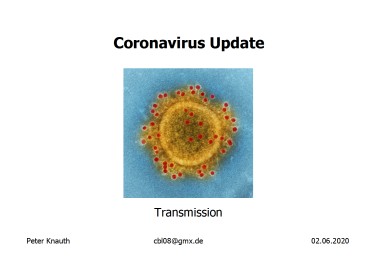
|
References:
Wei & Li (2016): Airborne spread of infectious agents in the indoor environment. Am. J. Infect. Contr.
Tang et al. (2013): Airflow dynamics of human jets: Sneezing ans breathing - potential sources of infectious aerosols. PLOS 1
Asadi et al. (2019): Aerosol emission and superemission during human speech increase with voice loudness. Nat.
Moriyama et al. (2020): Seasonality of respiratory viral infections. Ann. Rev. Virol.
Leung et al. (2020): Respiratory virus shedding in exhaled breath and efficacy of face masks. Nat. Med.
Chu et al. (2020): Physical distancing, face masks and eye protection to prevent person-to-person transmission of SARS-CoV-2 and Covid-19: a systematic review and meta-analysis. Lancet
Leclerc et al. (2020): What settings have been linked to SARS-CoV-2 transmission clusters? PREPRINT
|
SARS-CoV-2 y la respuesta inmune |

|
References:
Braciale et al. (2012): Regulating the adaptive immune response to respiratory virus infection. Nat. Rev. Immunol.
Blanco-Melo et al. (2020): Imbalanced host response to SARS-CoV-2 drives development of COVID-19. Cell
Zirui-Tay et al. (2020): The trinity of COVID-19: Immunity, inflammation and intervention. Nat. Rev. Immunol.
Prompetchara et al. (2020): Immune response in COVID-19 and potential vaccines: Lessons learned from SARS and MERS epidemic. EAPJAI
Fu et al. (2020): Understanding SARS-CoV-2-mediated inflammatory responses: From mechanisms to potential therapeutic tools. Virol. Sin.
Merad & Martin (2020): Pathological inflammation in patients with COVID-19: A key role for monocytes and macrophages. Nat. Rev. Immunol.
|
La patogénesis de COVID-19 |

|
References:
Wölfel et al. (2020): Virological assessment of hospitalized cases of coronavirus disease 2019. Nat.
He et al. (2020): Temporal dynamics in viral shedding and transmissibility of COVID-19. Nat.
Mason (2020): Pathogenesis of COVID-19 from a cell biologic perspective. Eur. Resp. J.
Basu-Ray & Soos (2020): Cardiac manifestations of coronavirus (COVID-19). Cureus
|
Entrada celular, Replicación de SARS-CoV-2 |
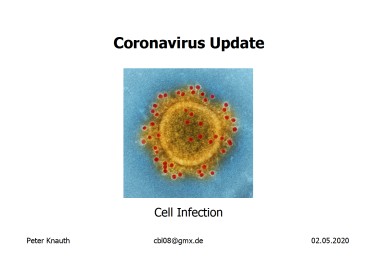
|
References:
Wang et al. (2020): Structural and functional basis of SARS-CoV-2 entry by using human ACE2. Cell
Hoffmann et al. (2020): SARS-CoV-2 cell entry depends on ACE2 and TMPRSS2 and is blocked by a clinically proven protease inhibitor. Cell
Hoffmann et al. (2018): Priming Time: How Cellular Proteases Arm Coronavirus Spike Proteins. Activation of Viruses by Host Proteases
Simmons et al. (2013): Proteolytic activation of the SARS-coronavirus pike protein: Cutting enzymes at the cutting edge of antiviral research. Antivir. Res.
Fehr & Perlman (2015): Coronaviruses: An Overview of Their Replication and Pathogenesis. Meth. Mol. Biol. vol. 1282
Astuti & Ysrafil (2020): Severe acute respiratory syndrome coronavirus 2 (SARS-CoV-2): An overview of viral structure and host response. Diabetes Metab. Syndr.
|
Clasificación, estructura, genoma, pandemias por HCoV |

|
References:
Park (2020): Epidemiology, virology, and clinical features of severe acute respiratory syndrome-coronavirus-2 (SARS-CoV-2; Coronavirus Disease-19). Clin. Exp. Pediatr.
Cascella et al. (2020): Features, evaluation and treatment coronavirus (COVID-19). StatPearls
Chen et al. (2020): Emerging coronaviruses: Genome structure, replication, and pathogenesis. J. Med. Virol.
Andersen et al. (2020): The proximal origin of SARS-CoV-2. Nat. Med.
Foster et al. (2020): Phylogenetic network analysis of SARS-CoV-2 genomes. PNAS

Last modified: 10.08.2022
 (17.05.2020)
(17.05.2020)














